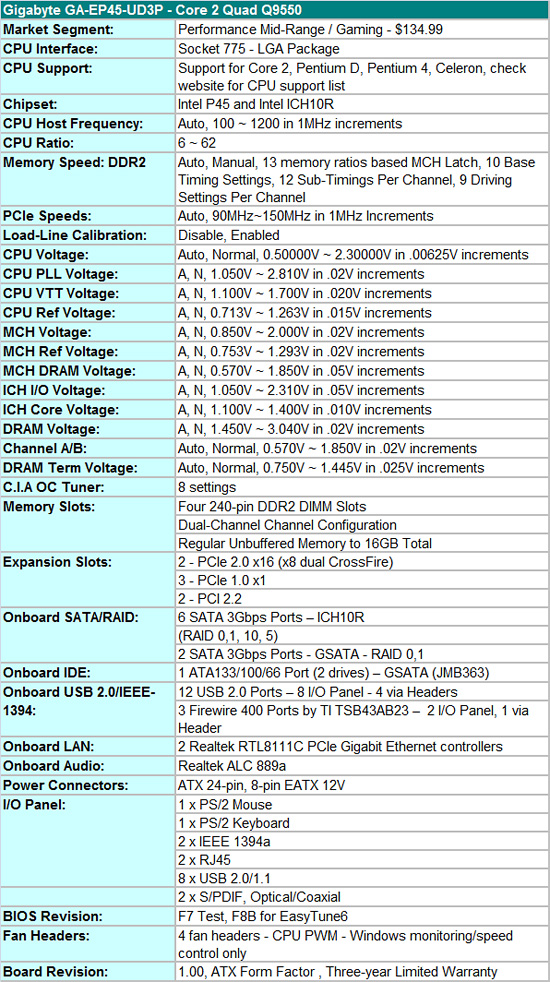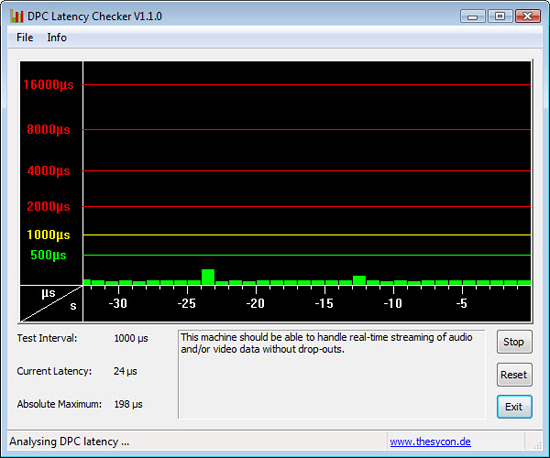Gigabyte GA-EP45-UD3P - P45 at its Finest
by Gary Key on February 3, 2009 12:15 AM EST- Posted in
- Motherboards
Gigabyte GA-EP45-UD3P
Feature Set

Gigabyte includes the standard array of components like the Realtek ALC889A HD audio codec with Dolby Home Theater support, dual Realtek RTL8111C Gigabit LAN chips with teaming support, T.I. TSB43AB23 IEEE 1394a chipset, GSATA2 (JMB363) chipset, Intel ICH10R, and full support for the Core 2 processor series, Pentium D, Pentium 4, and Celeron processors. Be sure to double check Gigabyte’s CPU support list to ensure full support for your processor.
Gigabyte also includes a rather generous accessories bundle for a motherboard in this price point. You get the standard rear I/O panel cover along with 1 x floppy cable, 1 x IDE cable, 4 x SATA cables, 1 x dual eSATA PCI expansion bracket with an eSATA cable and external molex connection, well-written and informative manual, software CD, and an illustrative installation guide.
BIOS
Gigabyte also includes one of the most extensive BIOS designs in a midrange motherboard that we have seen recently. The BIOS is setup for the serious overclocker and includes all the basic settings: CPU multiplier, PCI-E bus, Northbridge latch (FSB Strap), FSB frequency, memory multipliers, and nearly every voltage setting you will need. Gigabyte finally includes Load Load-Line Calibration (LLC) and ICH Core (Southbridge) voltage settings. LLC will help to eliminate line droop on the VCore line. We still recommend having LLC disabled in most situations, but if you have to reach a certain overclock for benchmarking, then you should probably enable it. Generally, we do not need ICH voltages in our experience but it is nice to have the feature.
Two strengths of the BIOS are the abundant voltage settings and extensive memory timing options. Gigabyte allows you to tweak tRD phase adjustments, DIMM clock skews, and memory driving strengths. For those who do not wish to tinker that much, Gigabyte provides Drive Strength Profiles (667/800/1066/OC-1200/OC-1333), which can take the guess work out of overclocking your memory. We found that these settings will get you about 98% of the way there when trying to get that last few ns in latency removed or ensuring memory stability when overclocking.
One last feature we would like to mention is the updated Q-Flash utility that is accessed via the F8 key. Q-Flash can read files directly from a USB flash drive making BIOS updating a simple and safe procedure. We tried this feature 100 times as part of our testing routine and it never failed.
We did have a couple of slight disappointments with the BIOS. In the voltage setting options, Gigabyte does not provide the base voltages that the board defaults to at startup. Our other complaint has to do with the PC Health section, as there is a lack of voltage and temperature readouts. Other than that, we were very impressed with the BIOS.
Tech
One of the most important features that Gigabyte implemented in the GA-EP45-UD3P motherboard is the Ultra Durable 3 technology. As a follow up to UD2, Gigabyte improved their component selections and electrical layout to optimize the board. Ultra Durable 3 features lower ESR solid capacitors, lower RDS(on) MOSFETs, and ferrite core chokes. Gigabyte now rates the longevity of the solid capacitors at 50,000 hours or approximately 6 years of continuous use.
The second major improvement cited by Gigabyte in their Ultra Durable 3 design is the introduction of a 2-ounce copper PCB for both the Power and Ground layers compared to the typical 1-ounce layers found in most consumer boards. Gigabyte claims this new motherboard design offers substantially lower system temperatures, superior energy efficiency, and improved overclocking. We are working on verifying the temperature and energy efficiency claims; both are certainly improved over the previous design but we need to understand if that comes from the BIOS, new heatsink design, and improved DES or if there really is something to UD3.
We have asked Gigabyte for their internal test results when it comes to board thermals and longevity of the capacitors. We would agree that overclocking is improved compared to the previous generation board. Whether that is BIOS or board design is up for debate, but considering our overclocking experiences, we think it is mostly board design. We will provide a follow-up shortly on DES and UD3; in the meantime, our simple comment is that this board is loaded and well built.
DPC Latency

We get a lot of requests for DPC latency results on each board we test. The latency variations between manufacturers utilizing the same chipset varies more than one might imagine. In the past, Gigabyte has had problems in this area. We are happy to report that it appears those problems are thing of the past, at least on this board. Our test used the E8600 at stock settings with 8GB of memory installed with timings set to 5-5-5-15 at DDR2-1066.










73 Comments
View All Comments
Nickel020 - Saturday, February 14, 2009 - link
Gary,many people including someone who posted here in the comments have the problem that the board won't boot in dual channel but everything is perfectly stable in single channel and the RAM sticks have all been verified to be working.
Did you experience this problem when reviewing the board? The standard Gigabyte tech support guy has no clue how to fix this problem :( Could you maybe contact someone at GB to see if they're aware of this issue and if there is a fix for it?
Would be great if you could do that!
Thanks!
Nickel020 - Saturday, February 14, 2009 - link
I've been working on it and it seems that the RAM runs fine in single channel mode and slots 1 & 2.Trying DIMM clock skew now to check whether this may fix it.
GhettoFly - Wednesday, February 11, 2009 - link
DFI's UT P45-T2RS isn't getting a lot of press coverage, but it's making some noise on enthusiast forums. Given Anandtech's excellent articles in the past on DFI boards, I was just curious if you guys planned to take a look at it, or was this Gigabyte the last P45 board you're going to review?The0ne - Tuesday, February 10, 2009 - link
I have the EP45-DS3R and it performs very well. I have the Q6600 up to 3.42Ghz with ST 800Mhz memory. OC much better than the dead IP35E MB it replaced and I had thought I bought a lower performing board since it cost me $95 at frys :)Believer - Monday, February 9, 2009 - link
I'm personally having major issues with this board and with my set of 4x2048MB OCZ Reavers.But then I don't receive cherry-picked products or have a hot-line to their tech support either.
Reading up on a quite a few tech forums now have shown me I'm far from the only one with similar issues too.
I suffer from the endless reboot cycling, the inability to boot with 4 memory modules installed and nonworking dual-channel support at either default, fail-safe or optimized BIOS settings.
Upgrading BIOS to F7 didn't solve anything either.
In order to get anything booted up I need to first install only 1 memory module, change in BIOS with upped Voltages to the MCH and DRAM, lower the FSB and/or memory to 800 and up the latencies.
With such a change I can boot with all 4 of my Reavers installed.
Yey...
I have a friend with this board and Reaver memory too, and he can't OC the board the slightest without it crashing... not even slightly past the default PC2-1066 memory speeds, with FSB 333. But he doesn't have the other basic memory issues I'm having though. His and mine CPU temperature readings are low into the 30ish degree Celsius area too.
Oh, and I might add I'm into my second RMA of the board without much of an improvement. The 2 boards showed two very different kind of memory issues though. But my memory runs just fine as long as I install them one and one, or 2 without dual channel config, I've stress tested them endlessly on default settings like that without problems.
Anyone with similar issues that know what could be the fault?
I have not get any response from Gigabyte's own tech support regarding this. Me and a few others with similar issues are being ignored on one of their own official support threads. That's service...
I'm having a tech support from OCZ to help me sort out the problems too however, but he's leaning that it would seem to be my boards fault... again.
Seem like third RMA might be getting closer.
... or I sit and drum my fingers waiting for Gigabyte to finally address the issues.
Jynx980 - Friday, February 13, 2009 - link
Mine wouldn't even boot up. The CPU fan would not spin. A couple of other people on the Newegg reviews mention this problem also. How long did it take you to get your RMA approved? Mine is still "open" after a week. Tech support was ok. It took a couple of days but they did respond. Also haven't heard anything about the mail in rebate, and that's been about a month. I sent in a mushkin rebate on the same day to the same rebate center and I already have gotten the check.syseng - Friday, June 12, 2009 - link
Gigabyte is obviously having financial problems. After 4 months, I do not have the rebates for my motherboard or graphics card. The companyhandling the rebates said Gigabyte has not released rebate checks in "quite a while". Resellers like Newegg should just drop them if they are not going to honor their commitments.Isme - Thursday, December 3, 2009 - link
Gigabyte has had "financial" problems for 15 years. Quality has varied from time to time though it has usually been cases of bad engineering rather than bad workmanship.I think the "financial" problems aspect is that they are just cheap skates who intend that if anyone gets shafted on a deal it won't be Gigabyte. That is to say that direct exchanges have never been pleasant for private individuals. You really want to be buffered through a retailer or wholesale who is doing mass returns...or be an important reviewer...or just very patient.
Believer - Monday, February 9, 2009 - link
Correct that, I just got a generic response from one of Gigabyte Tech Support.Looks like they're trying to pin-point it to the memory modules as no ordinary combination of 2 memory pairs are ever specifically supported to work together.
Isme - Thursday, December 3, 2009 - link
Hmmm...does that mean the board really only supports a single dual channel pair? That would mean the other 2 slots are basically there is nice looking decoration only.Or was that response simply saying that Gigabyte never tested the motherboard with all 4 slots filled with off-the-shelf memory rather than hand-picked laboratory measured memory modules? Thus their answer could be more accurately paraphrased "we haven't got a clue and its your problem now sucker". With the whole overclocking fad I can sort of see this as a corporate answer (HObbyist know as much as we do and are willing to spend time -- so why should we waste our time providing a solution).
Still it would be nice if they proved their claims using at least a couple sets of stock hardware in an non-overclocked configuration BEFORE releasing and advertising to the general public.